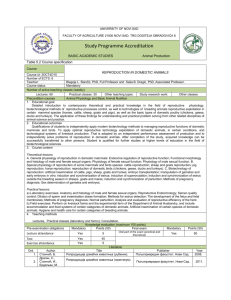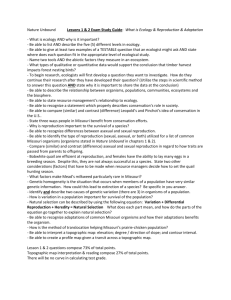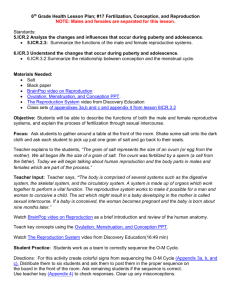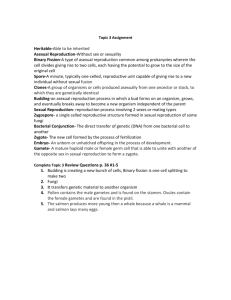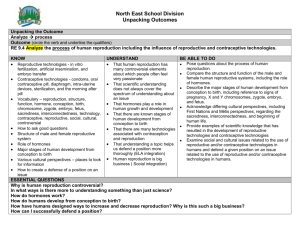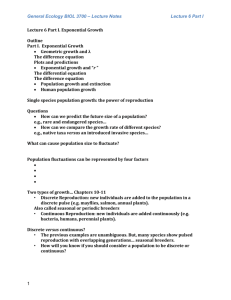Lecture notes - Justin C. Bagley
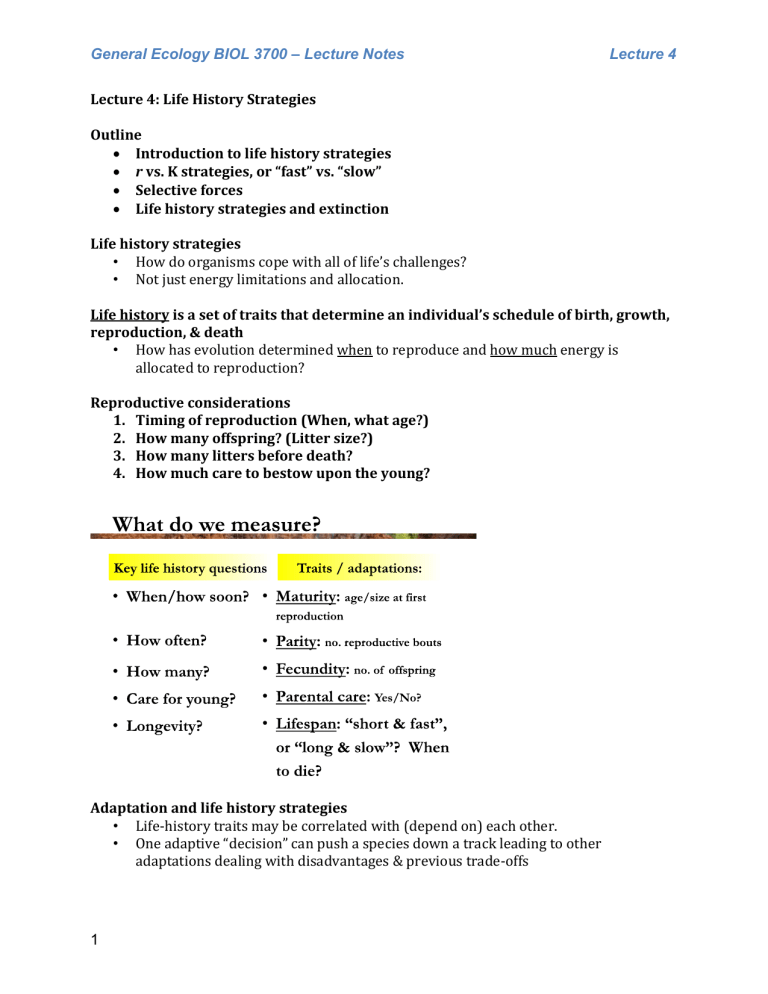
General Ecology BIOL 3700
– Lecture Notes
Lecture 4
Lecture 4: Life History Strategies
Outline
Introduction to life history strategies
r vs. K strategies, or “fast” vs. “slow”
Selective forces
Life history strategies and extinction
Life history strategies
• How do organisms cope with all of life’s challenges?
• Not just energy limitations and allocation.
Life history is a set of traits that determine an individual’s schedule of birth, growth,
reproduction, & death
• How has evolution determined when to reproduce and how much energy is allocated to reproduction?
Reproductive considerations
1.
Timing of reproduction (When, what age?)
2.
How many offspring? (Litter size?)
3.
How many litters before death?
4.
How much care to bestow upon the young?
Adaptation and life history strategies
• Life-history traits may be correlated with (depend on) each other.
• One adaptive “decision” can push a species down a track leading to other adaptations dealing with disadvantages & previous trade-offs
1
General Ecology BIOL 3700
– Lecture Notes
Lecture 4
• This is how a comprehensive life-history strategy evolves: “adaptations that constrain future adaptations”
Extremes in fecundity!
Smallest clutch size is one!
• Blue whales have a single offspring the size of an adult African elephant!
• The European brown bat, Pipistrellus pipistrellus has twins whose combined weight is 50% of the mother’s weight! o Can eat up to 3000 insects per night!
• Kiwis (at 2 kg) lay a single 350-400 g egg!
Extremes in fecundity!
Largest clutches:
Some bivalves and fish have clutch sizes of 10,000,000 each time they reproduce.
Ocean Sunfish (Mola mola) females can generate 300 million eggs at once (more than any other vertebrate) … the eggs are released into the water column and fertilized by sperm
Extremes in fecundity!
Largest clutches:
Orchids, also produce millions of seeds, each with a 10 -9 probability of surviving to reproduce.
How much do the life histories of organisms vary among species?
Why do fishes vary more than any other vertebrate group?
Discuss
Extremes in longevity
What is the world’s oldest living vertebrate?
What is the world’s oldest living thing?
Oldest dead animal (Bilateria)
The team from Bangor University in Wales was dredging the waters north of Iceland as part of routine research when the unfortunate specimen belonging to the clam species Arctica islandica, commonly known as the Ocean Quahog, was hauled up from waters 250 feet deep.
Only after researchers cut through its shell, which made it more of an ex-clam, and counted its growth rings, did they realize how old it had been—between 405 and
410 years old.
– Bangor University Press
Meet Methuselah
2
General Ecology BIOL 3700
– Lecture Notes
Lecture 4
• Methuselah, a Great Basin Bristlecone Pine (Pinus longaeva), is the oldest living thing in North America
• 4,842 years old
• Lives 10,000 – 11,000 ft. in elevation along northern California’s White Mountains… part of Sierra Nevada range
What do all of these long-lived species share in common?
How would this determine or affect longevity?
Discuss.
MacArthur and Wilson were the first to classify species according to their life history traits/strategies
r-strategists, e.g. Dandelions, have fast life cycles…
• Rapid growth and development to maturation
• Early reproduction
• Semelparity & produce many small vulnerable young
• No parental care
• Poor competitive ability, but good dispersal ability
K-strategists, e.g. bears, have slow life cycles…
• Slow growth and development to maturation
• Delayed reproduction
• Iteroparity & produce a few well fortified young.
• Parental care common
• Good competitive ability
Hibernating mammals tend towards a K-strategy
Hibernation is thought to have evolved as a strategy for avoiding extreme environmental conditions in seasonal climates. Hibernators, however, are also found in the tropics and will sometimes continue to hibernate after mild conditions, and plentiful food, return.
Other forces, therefore, may act to make hibernation, which is present in nearly half of all mammalian orders. Hibernation lowers metabolism and conserves energy, and also removes them from the external environment, perhaps affecting survival. Turbill et al. reviewed the published literature on 19 species of mammalian hibernators and found that, indeed, annual survival and total life span in hibernating mammals are greater than they are in nonhibernators of the same size.
Hibernators also have a "slower pace of life," including a delay in maturity, lower annual reproductive output, and longer generation time.
This analysis suggests that small hibernating mammals may trade high annual reproduction for a longer reproductive life, a successful life history strategy that is seen more often in large, long-lived mammals.
Proc. R. Soc. London ser B 278
3
General Ecology BIOL 3700
– Lecture Notes
Lecture 4
“r” and “K”?
Terms used in population growth models.
More later.
Advantages of an r-strategy?
• Don’t take the risk of delaying reproduction. Early reproductive output will rapidly achieve some level of fitness.
• They always have a lot of offspring available to exploit ephemeral resources.
Disadvantages of an r-strategy?
• Usually small
• Only one chance at reproduction
• No parental care
Advantages of a K-strategy?
• Large size
• Increased longevity o Parental care
• Multiple chances at reproduction
Disadvantages of a K-strategy?
• Can die before reproducing
• Your fitness investment lies with just a few offspring
r and K strategies represent extremes along a LH continuum
Most species have attributes of both depending on which selective forces are most important and previous adaptations that may constrain current adaptive possibilities
Example:
• Green Sea Turtles
(Chelonia midas) have both r- and K-traits
Current emphasis not on classifying species as r or K, but on selective forces producing adaptations with trade-offs
A strategy may resemble r or K, or some mixture of r and K
Life history trade-offs
Sheep example
4
General Ecology BIOL 3700
– Lecture Notes
Lecture 4
Lifetime reproductive allocation for iteroparous organisms: how much and when?
Balancing competing demands:
• Balancing competing demands:
Body Maintenance
Available energy
Growth
Reproduction
• “Cost of reproduction”
– Allocation to current reproduction comes at cost to future reproductive opportunities
Life history trade-offs: allocation of energy to competing demands
5
General Ecology BIOL 3700
– Lecture Notes
Cost of reproduction: allocation to current
versus future reproduction should change with age
Age-1 Age-2 Age-3 Age-4
Lecture 4
Low investment to current reproduction
H igh investment to current reproduction
Reproductive restraint
Terminal investment
Other cues besides age also affect reproductive investment
• State-based cues
Terminal investment
Reproductive restraint
• Environment-based cues
Age-specific mortality
• Semelparity, and rapid growth to early maturity, is selected for if adults have a low probability of survival.
• Iteroparity and more of a “K” strategy are selected for if there is a high probability of adult survival.
What “forces” can reduce adult mortality and select for K-traits?
• Those that select for large body size:
Reduced predation
Better competitor
Better tolerate
• cold temperatures
Examples…
German cockroach
• Adult mortality is high and lifespan is 1 year
• Adults are small (5/8 inch)
• Adults lay 1 egg case every 20 – 25 days.
• Egg cases contain 30 – 40 eggs.
• Nymphs mature in 100 days.
• No parental care.
6
General Ecology BIOL 3700
– Lecture Notes
Lecture 4
Madagascar hissing cockroach
• Adult mortality is low and lifespan is 3 - 5 years
• Adults are large (2 - 3 inches)
• Adults lay 1 batch of eggs every 6 months
• One batch contains 15 – 50 eggs
• Nymphs mature in 6 months
• Parental care:
Eggs are carried inside the mother for 60 days after hatching.
Young nymphs remain under the mothers care for 6 months until they reach adulthood.
A shift in selective forces can cause a shift in life-history strategy
• Historically, female cod matured at 60 cm and produced 2 million eggs, while at 120 cm they produce 15 million eggs. This is a positive relationship between delayed reproduction and lifetime fitness.
• However, the largest fish are overexploited, causing a shift in life history. They now grow more quickly and mature at 40 cm because they shift energy into reproduction earlier in life before they are caught and killed. Now they produce < 500,000 eggs.
• We are selecting against large body size and large populations… the most valuable traits to humans.
Evolution caused by humans can be very fast
Proc. Natl. Academy Sci. 106:952, 2009
• Predation by humans drives changes in exploited prey much faster than other evolutionary pressures do.
• Previous research has shown that commercial fishers and trophy hunters can mold traits such as average size at reproductive age in wild populations, but no single study has revealed the pace at which these changes generally take place. In a metaanalysis of work on the morphology and life histories of 29 species, including fish, mammals and plants, Chris Darimont of the University of California, Santa Cruz and his colleagues found that changes in human harvested systems occurred more than
300% faster than in natural systems, and 50% faster than in systems affected by other human influences, such as pollution.
• The authors suggest that human predation works so quickly because it is often felt by large proportions of the adults in populations.
Rarity has 3 components: o geographic range o habitat tolerance o local population size
What life history traits can increase the probability of extinction?
•
How does body size relate to extinction risk?
7
General Ecology BIOL 3700
– Lecture Notes
Lecture 4
• Negative correlation between body size and density
What about other animals?
• The negative correlation holds across other groups.
What about plants?
• Again, similar pattern.
• But why is there a relationship between body size and population size at all?
We speak in generalities, but…
…each species has its own unique life history strategy and thus, story of success or extinction. o The Passenger Pigeon o The Allee effect.
************* The End of Lecture 4 *************
8


